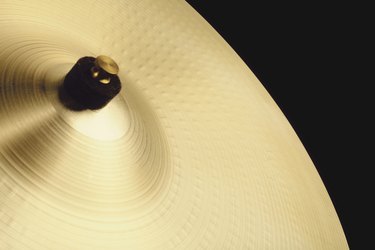
Audacity is a free, open source audio recording and editing application. If you have an audio recording that contains a metallic sound that you would like to remove, you can use Audacity's "equalization" effects tool to reduce the frequency range where the metallic sound operates. By reducing the frequency associated with the metallic sound, you can eliminate or significantly diminish your perception of that sound. Metal sounds generally occur in the range of 7 kilohertz to 9 kilohertz. The frequency of a shimmering hi-hat cymbal, for example, is around 7.5 kilohertz.
Step 1
Click "File" in the menu. Select "Open." Browse to the directory that is the location of the audio file you want to edit. Click on the file to select it. Click "Open" to load it into Audacity.
Video of the Day
Step 2
Click the "Play" button to listen to the audio wave in order to locate the section of the wave that contains the metallic sound you want to get rid of. Click "Stop" when you find the part of the audio you want to edit.
Step 3
Click and hold the left mouse button, and drag it over the portion of the wave that contains the metallic sound you want to remove. This should highlight the part of the audio wave you want to remove.
Step 4
Click to open the "Edit" menu. Select "Equalization." The Equalization dialog box will open.
Step 5
Double-click on an area around the 8000 Hz mark on the purple equalization spectrum line. This will place a plot mark on the line.
Step 6
Double-click around the 7000 Hz mark on the equalization line to insert another plot mark. Insert another plot mark around the 9000 Hz mark. You should now have a total of three plot marks on the equalization line.
Step 7
Click and hold on the 8000 Hz plot mark. Drag the mark down to the -24 dB level. The equalization line should now look like a flat line with a big dip near the end.
Step 8
Click the "Preview" button to assess how much you have reduced the metallic sound.
Step 9
Drag the bottom plot mark a little to the left if you can still hear a high-pitched whisper of the metallic sound. Drag this mark a little to the right if you can still hear a dull, low-pitched whisper of the metallic sound. Click "Preview" again to review the results. Repeat as necessary. Play around with the setting of the bottom plot mark until you feel you have isolated the frequency for this particular metallic sound. You will know you have isolated the frequency when you no longer hear the metallic sound or it's very faint.
Step 10
Drag the top-left plot mark a little to the right and the top-right plot mark a little to the left to narrow the field of equalization, if you so desire. Click "Preview" to hear the results. Readjust if need be.
Step 11
Click "OK" to save the equalization settings.
Video of the Day